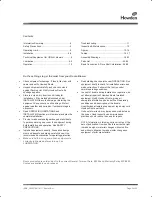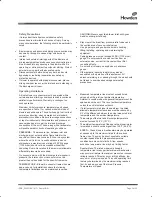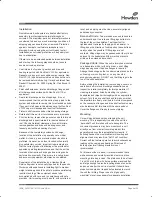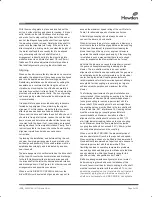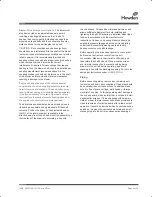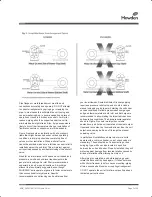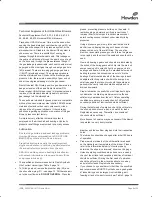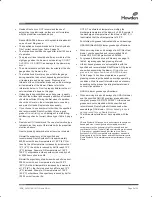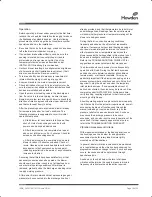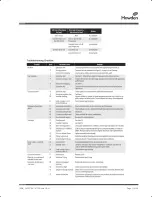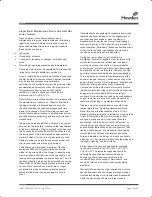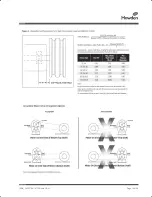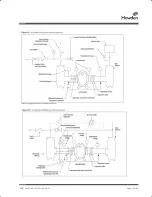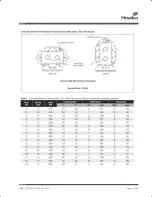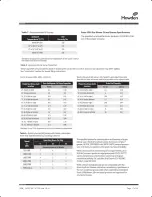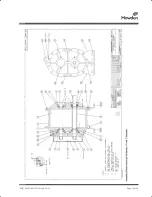
ISRB_2002 GEA 19171 Roots URAI
Page 4 of 32
Installation
Roots blowers & exhausters are treated after factory
assembly to protect against normal atmospheric
corrosion. The maximum period of internal protection is
considered to be one year under average conditions, if
shipping plugs and seals are not removed. Protection
against chemical or salt water atmosphere is not
provided. Avoid opening the unit until ready to start
installation, as corrosion protection will be quickly lost
due to evaporation.
If there is to be an extended period between installation
and start up, the following steps should be taken to
ensure corrosion protection.
Coat internals of cylinder, gearbox and drive end
bearing reservoir with Nox-Rust VCI-10 or equivalent.
Repeat once a year or as conditions may require. Nox-
Rust VCI-10 is petroleum soluble and does not have to
be removed before lubricating. It may be obtained from
Daubert Chemical Co., 2000 Spring Rd., Oak Brook, Ill.
60521.
Paint shaft extension, inlet and discharge flanges, and
all other exposed surfaces with Nox-Rust X-110 or
equivalent.
Seal inlet, discharge, and vent openings. It is not
recommended that the unit be set in place, piped to the
system, and allowed to remain idle for extended periods.
If any part is left open to the atmosphere, the Nox-Rust
VCI-10 vapor will escape and lose its effectiveness.
Protect units from excessive vibration during storage.
Rotate shaft three or four revolutions every two weeks.
Prior to start up, remove flange covers on both inlet and
discharge and inspect internals to insure absence of
rust. Check all internal clearances. Also, at this time,
remove gearbox and drive end bearing cover and
inspect gear teeth and bearings for rust.
Because of the completely enclosed unit design,
location of the installation is generally not a critical
matter. A clean, dry and protected indoor location is
preferred. However, an outdoor location will normally
give satisfactory service. Important requirements are
that the correct grade of lubricating oil be provided for
expected operating temperatures, and that the unit be
located so that routine checking and servicing can be
performed conveniently. Proper care in locating driver
and accessory equipment must also be considered.
Supervision of the installation by a Howden Roots
Service Engineer is not usually required for these units.
Workmen with experience in installing light to medium
weight machinery should be able to produce satisfactory
results. Handling of the equipment needs to be
accomplished with care, and in compliance with safe
practices. Unit mounting must be solid, without strain or
twist, and air piping must be clean, accurately aligned
and properly connected.
Bare-shaft Units:
Two methods are used to handle a
unit without base. One is to use lifting lugs bolted into
the top of the unit headplates. Test them first for
tightness and fractures by tapping with a hammer. In
lifting, keep the direction of cable pull on these bolts as
nearly vertical as possible. If lifting lugs are not
available, lifting slings may be passed under the cylinder
adjacent to the headplates. Either method prevents
strain on the extended drive shaft.
Packaged Units:
When the unit is furnished mounted
on a baseplate, with or without a driver, use of lifting
slings passing under the base flanges is required.
Arrange these slings so that no strains are placed on the
unit casing or mounting feet, or on any mounted
accessory equipment. DO NOT use the lifting lugs in the
top of the unit headplates.
Before starting the installation, remove plugs, covers or
seals from unit inlet and discharge connections and
inspect the interior completely for foreign material. If
cleaning is required, finish by washing the cylinder,
headplates and impeller thoroughly with an appropriate
solvent. Turn the drive shaft by hand to make sure that
the impellers turn freely at all points. Anti-rust compound
on the connection flanges and drive shaft extension may
also be removed at this time with the same solvent.
Cover the flanges until ready to connect piping.
Mounting
Care will pay dividends when arranging the unit
mounting. This is especially true when the unit is a
“bare-shaft” unit furnished without a baseplate. The
convenient procedure may be to mount such a unit
directly on a floor or small concrete pad, but this
generally produces the least satisfactory results. It
definitely causes the most problems in levelling and
alignment and may result in a “Soft Foot” condition.
Correct soft foot before operation to avoid unnecessary
loading on the casing and bearings. Direct use of
building structural framing members is not
recommended.
For blowers without a base, it is recommended that a
well anchored and carefully levelled steel or cast iron
mounting plate be provided. The plate should be at least
1 inch (25 mm) thick, with its top surface machined flat,
and large enough to provide levelling areas at one side
and one end after the unit is mounted. It should have
properly sized studs or tapped holes located to match
the unit foot drilling. Proper use of a high quality
machinist’s level is necessary for adequate installation.
ISRB_2002 GEA 19171 Roots URAI.indd 4
17/09/2015 12:52
Summary of Contents for Roots Metric Series
Page 11: ...ISRB_2002 GEA 19171 Roots URAI Page 11 of 32...
Page 13: ...ISRB_2002 GEA 19171 Roots URAI Page 13 of 32...
Page 14: ...ISRB_2002 GEA 19171 Roots URAI Page 14 of 32...
Page 15: ...ISRB_2002 GEA 19171 Roots URAI Page 15 of 32...
Page 16: ...ISRB_2002 GEA 19171 Roots URAI Page 16 of 32...
Page 17: ...ISRB_2002 GEA 19171 Roots URAI Page 17 of 32...
Page 18: ...ISRB_2002 GEA 19171 Roots URAI Page 18 of 32...
Page 19: ...ISRB_2002 GEA 19171 Roots URAI Page 19 of 32...
Page 20: ...ISRB_2002 GEA 19171 Roots URAI Page 20 of 32...
Page 21: ...ISRB_2002 GEA 19171 Roots URAI Page 21 of 32...
Page 22: ...ISRB_2002 GEA 19171 Roots URAI Page 22 of 32...
Page 23: ...ISRB_2002 GEA 19171 Roots URAI Page 23 of 32...
Page 24: ...ISRB_2002 GEA 19171 Roots URAI Page 24 of 32...
Page 25: ...ISRB_2002 GEA 19171 Roots URAI Page 25 of 32...
Page 26: ...ISRB_2002 GEA 19171 Roots URAI Page 26 of 32...
Page 27: ...ISRB_2002 GEA 19171 Roots URAI Page 27 of 32...
Page 28: ...ISRB_2002 GEA 19171 Roots URAI Page 28 of 32...
Page 29: ...ISRB_2002 GEA 19171 Roots URAI Page 29 of 32...
Page 30: ...ISRB_2002 GEA 19171 Roots URAI Page 30 of 32...


